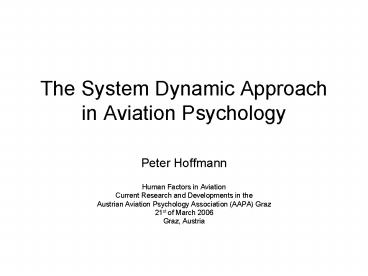The System Dynamic Approach in Aviation Psychology - PowerPoint PPT Presentation
1 / 27
Title:
The System Dynamic Approach in Aviation Psychology
Description:
Current Research and Developments in the. Austrian Aviation Psychology Association (AAPA) Graz ... Increas the safety puffer. Increase the safety puffer. Conclusion ... – PowerPoint PPT presentation
Number of Views:132
Avg rating:3.0/5.0
Title: The System Dynamic Approach in Aviation Psychology
1
The System Dynamic Approach in Aviation Psychology
- Peter Hoffmann
- Human Factors in Aviation
- Current Research and Developments in the
- Austrian Aviation Psychology Association (AAPA)
Graz - 21st of March 2006
- Graz, Austria
2
ATCOs work in a complex system
Other Sectors
Pilots
Other ATCOs
ATCO
Flight Data Assistance
Flow Management
Supervisor
ATM
Working with different professionals
3
ATCOs work in a complex system
In different..
..environments
4
ATCOs work in a complex system
Working with different tools
5
ATCOs work in a complex system
ATCOs communicate and coordinate between
different units/systems
6
very complex cognitive processes
Decision making Situational Awareness Communicat
ion
7
Decision making
- Decision Making
- Takes place in a multi-task setting
- And in a multi-demand setting
- ATC's are expert decision makers
8
How do ATCOs make decisions
Decision making can be considered a series
of rational mental steps
detect problems
recognise problems
act and check the result
diagnose problems
determine the risk with each alternative and
choose one
determine available alternatives
9
Individual Situational Awareness
Mental Models
Previous Experience
Mental Picture - current
Mental Picture - future
Future Traffic Picture
Current Traffic Picture
Actual traffic information
- Displays
- Environment
Actual Traffic Picture
10
Individual Situational Awareness
Weather
Adjacent Centres
Personal Factors
Airport Infrastructure
Equipment
Situational Awareness
Colleagues
Aircraft Performance
Traffic
Navigational Aids
Operators Pilots
Environment
11
Team Situational Awareness
Information available
Chemistry
Information exchange
Shared knowledge
Previous shared experience
TSA
Shared training
?
Communication -tacit -non tacit
?
Shared mental model of colleague
Shared mental model of pilot
12
ATCO's can hear without listening...
- Background monitoring of
- communication between
- controllers
- communication with the
- supervisor
- what is going on in the
- room
- radio communications
- with pilots, through
- loudspeakers (when used)
13
Good radio communication practice
- Your readbacks and hearbacks must be accurate and
timely - Check you understand and are understood
- slow down and 'chunk' information
- repeat information and articulate clearly
- ask for feedback
- ask for a repetition or more information
- provide feedback
- cross-check with colleagues
- WARNING Using non-standard phraseology is the
most common aviation violation and endangers
safety!
14
The effect of load
- When we are very busy we may not be able to
process information in a rational, systematic and
accurate manner. As a result we - omit information
- make errors
- fill in
- approximate
15
How does all these factors lead to a safe
ATM-System ?
The Sensitivity Modell by Frederic Vester It is
based on
Fuzzy
Logic
System Dynamic Approach Not only the elements of
a system are important It is more the
relationship between these elements. (F.Vester)
16
AMPHII - ModellATCO Manpower Planning Human
Issues Impactby Human Factors Business Division
(DAS/HUM)Eurocontrol
17
The Impact Matrix
18
Systemic Role for the ATM-System
19
The SET-Tool
Safety buffer
Safety
Traffic mix Dynamic Density (Complexity) Number
of a/c Amount of requests Weather .....
Separation level Direct routing Requested
flightlevel
efficiency
taskload
20
Balanced SET-System no additional s-buffer,
average efficiency, average taskload
21
Unbalanced System reduced safety-buffer,
average efficiency, high taskload
22
SET-SzenarioUnbalanced System
23
Dependency between taskload and efficiency
24
Increase the safety puffer
1 Minute
Increase efficiency
Increase taskload
Decrease taskload
25
Increas the safety puffer
26
Increase the safety puffer
27
Conclusion
The SET-tool helps to show what will be the best
way to decrease workload by efficient TEM (threat
and error management). With the SET-tool we can
analyse the influence of threat and error
management actions by the ATCO to his
workload. In the simulator training we can try
different solutions and their effect to ATCOs
workload. (e.g. reducing taskload earlier) ATCOs
get a feedback immediately after the behaviour
session and can try better solutions with the
SET-tool.































